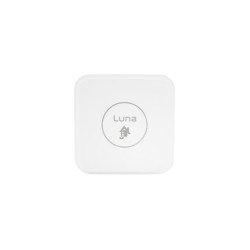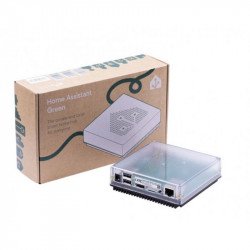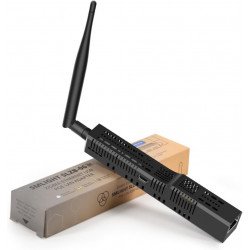Do you want to automate lights inside the house and also in the garden, open or close blinds and other actions according to the brightness measured outside? Mumubiz offers a Zigbee outdoor light sensor.
Why is the Mumubiz brightness sensor have this price?
This Mumubiz Zigbee light sensor incorporates Zigbee technology, a solar panel and is designed for outdoor use at an attractive price.

Advantages and disadvantages of the Mumubiz light sensor
Advantages
- Zigbee technology: If you want to unify your smart home, Zigbee technology is an excellent option with different smart devices from different brands on the market.
- Compatibilities: This Mumubiz Zigbee brightness sensor is compatible with Tuya Smart Life, Home Assistant and Jeedom hubs with Zigbee2MQTT.
- Price: The price of this sensor is affordable.
- Solar panel: No need for battery maintenance as this sensor integrates a solar panel.
- Outdoor use: This Zigbee light sensor can be installed in your garden.
Disadvantages
- Zigbee hub required: In order to have the history of brightness detections, it is necessary to use a compatible Zigbee hub.
Tutorial on how to use the Mumubiz brightness sensor
Let’s discover the details of this Zigbee Mumubiz light sensor.

General features of the Mumubiz Zigbee light sensor
To begin with, if we open the packaging, we have:
An instruction manual.

An accessory to open the sensor.

A 3M adhesive.

2 plugs and screws.

And, of course, the Mumubiz brightness sensor.

In the smart home market with Zigbee technology, it was not common to see an outdoor brightness sensor.

Therefore, this sensor is unique and can help us in many automations.

Its dimensions are 63x63x21 mm.

And it is white on the bottom and with a solar panel on the top, so you don’t need battery maintenance, which is an interesting first detail.

Operates outdoors in temperatures from -20 to +70 °C.

Its main function is to measure the brightness of the environment with a measurement range of 0 to 83,000 Lux with a high sensitivity of 5 Lux, being able to detect very slight changes in brightness.

We can see this brightness sensor on the front of the device.

It incorporates Zigbee wireless technology, so you need a compatible Zigbee home automation hub such as one from Tuya Smart Life.

Jeedom or Home Assistant with the Zigbee2mqtt platform to be able to send these brightness measurements.

On the back, we have the delimited area to put the 3M adhesive and stick it on a wall.

Around the sensor we can see a gasket that serves to protect the electronics from water and to ensure that it is rainproof.

On the inside you have indicators on the cover if you want to fix this sensor with plugs and screws.

We can see a Ni-MH battery that is used to recharge the solar panel so that this sensor can work both day and night.

And there is a physical button for resetting and for linking the sensor to a compatible Zigbee hub.

How to link the Mumubiz Zigbee brightness detector
How to link the Mumubiz brightness detector with Zigbee2Mqtt
To link the Mumubiz Zigbee brightness sensor, you must put your home automation hub in association mode.

You must open the back of the sensor with the included accessory that serves as a lever.

And you have to press the physical button of the Zigbee light sensor for 5 seconds and its LED indicator should flash, meaning that it is in inclusion mode.

You should now see your device appear in the Zigbee2mqtt interface.

How to link the Mumubiz light detector with Tuya Smart Life
With a Tuya hub, the process is similar. From the Smart Life app on your phone, click on the “+” button at the top right and “Add device”.

At this point, you need to press the physical button on the Zigbee light sensor for 5 seconds and its LED indicator should flash, meaning that it is in inclusion mode.

You should now see your device appear in the Smart Life interface.

Detailed features of the Mumubiz Zigbee brightness detector
Let’s discover the detailed functions of this device.
Zigbee brightness detector functions in Zigbee2Mqtt
In Zigbee2mqtt, which you can use with Home Assistant or Jeedom, although this device is listed as unsupported, i.e. it has not yet been integrated by developers in version 2.6, we can still take advantage of its information.

“Battery” allows you to view the battery status in percentage.

“Illuminance” is the real-time brightness measurement in Lux by the sensor.

Of course, we will have a history of these measurements over time, knowing that the sensor will send its brightness measurements every time there is a sudden change or at 180-second intervals if there is no sudden change.

And “Link quality” is the quality of the link, i.e. whether our sensor has good or bad communication range with our Zigbee hub.

If you want to know more, I have content about this Zigbee LQI and how to improve it.
Functions of the Zigbee brightness detector in Tuya Smart Life
In the Smart Life application, you can see in real time the brightness measured by the sensor and you can also see a history of the brightness measurements over time.

And the sensor will send its brightness measurements every time there is a sudden change or at intervals of 180 seconds if there is no sudden change.

In the settings, you can see the battery level in percentage.

How to install the Mumubiz Zigbee light sensor
Once you have linked your sensor to a compatible Zigbee hub, you can install it in your garden, in an area with good exposure to natural light, on a wall by sticking it with 3M adhesive or screwing it with its plugs and screws.

Of course, you should avoid installing it in a shaded area all day or near reflective surfaces that may alter the brightness readings and avoid false measurements.

And when communicating with Zigbee technology, you should consider the direct range with your Zigbee hub which is generally 10 to 15 metres, but of course you can improve this range by purchasing any Zigbee device connected to the power supply such as light bulbs, sockets, modules except those without a neutral and any other Zigbee device.

Automations with a brightness sensor
As I often say, your imagination is your limit. This Zigbee brightness sensor can be very useful to turn on garden lights only when the measured brightness is below a value you have defined.

And you can do the same inside the house, switching on lights only in case of detected movement and low brightness.

You can also create routines for opening or closing the blinds according to the brightness measured in the garden, both for waking up in the morning or going to bed at night, as well as for thermal protection in summer or sunlight in winter.

In short, this outdoor Zigbee light sensor can be another ally for your smart home project, with an attractive price, compatibility with the most popular hubs on the market and no battery maintenance thanks to its solar panel.

Generally purchased together



Buy now your Mumubiz Zigbee light detector

Graduated with a Higher Technician’s Certificate in Home Automation, a Professional Bachelor’s degree in E-commerce and Digital Marketing, and a Master’s degree in SEO, I have been working since 2013 in a home automation e-commerce company called Domadoo, where I have the opportunity to test a large number of the popular Smart Home products on the market.